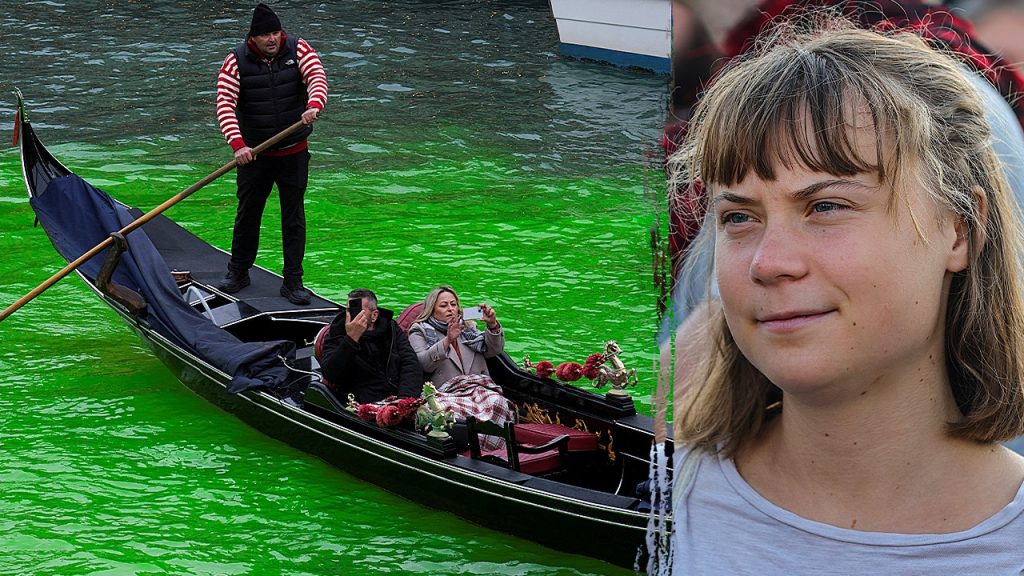Greta Thunberg Faces Consequences After Venice Canal Protest
In a dramatic display of environmental activism that has sparked both international attention and local outrage, 22-year-old climate activist Greta Thunberg has been temporarily banned from Venice and fined after participating in a protest that turned the iconic Grand Canal a fluorescent green. The Swedish activist, alongside approximately 35 other Extinction Rebellion demonstrators, received a 48-hour expulsion order from the historic Italian city and a $172 fine following their coordinated action. The protest coincided with the conclusion of the COP30 United Nations climate conference in Brazil, with Extinction Rebellion organizing simultaneous demonstrations across ten Italian cities in what they described as an urgent call to address climate change impacts on vulnerable coastal regions.
The activists maintain that their methods were environmentally responsible, insisting the fluorescent substance was a non-toxic tracer commonly used in environmental research for monitoring water flows and detecting leaks. Extinction Rebellion emphasized that their dramatic visual statement was carefully designed to highlight Venice’s particular vulnerability to climate change without causing ecological harm. The group’s concern focuses on Venice’s precarious position as one of Europe’s cities most threatened by rising sea levels and increasingly frequent flooding events that endanger its historic architecture and cultural heritage. Their protest carried the stark message “Stop Ecocide,” dramatically displayed on a banner hung from the city’s iconic Rialto Bridge, while silent protesters dressed in striking red veils moved through crowds of tourists, creating a ghostly visual reminder of environmental urgency.
The Venice demonstration represented just one element of a coordinated nationwide campaign across Italy. In Genoa and Padova, fountains were transformed with the same green dye, while rivers in Turin, Bologna, and Taranto underwent similar colorful transformations as part of the synchronized protest action. These visually arresting demonstrations were specifically timed to coincide with the end of the global climate conference, expressing frustration with what activists view as insufficient commitment to meaningful climate action. Extinction Rebellion directly criticized Italian Prime Minister Giorgia Meloni’s government for what they characterized as resistance to stronger climate protection measures during the Brazilian environmental summit, suggesting that Italian leadership was failing to acknowledge the particular vulnerability of their own historic coastal cities.
However, local authorities responded with swift condemnation of the activists’ methods. Veneto Province Governor Luca Zaia criticized the protest as potentially environmentally harmful, despite the activists’ assurances regarding the safety of the substances used. The governor’s statement reflected concern that the very environmental systems the protesters sought to protect might be damaged by their demonstration techniques. Beyond potential environmental impacts, Zaia framed the protest as fundamentally disrespectful to Venice itself, its rich cultural history, and its delicate ecological balance – suggesting that the activists’ methods contradicted their stated concern for the city’s vulnerability to climate impacts.
This incident represents the latest in a series of controversial actions by Thunberg, who has increasingly aligned herself with more confrontational forms of climate activism. Her evolution from the solitary school striker who captured global attention to a participant in direct action protests reflects broader shifts in climate activism strategies as frustration grows over the pace of governmental response to climate concerns. The Venice action demonstrates how climate protest movements are increasingly turning to visually dramatic and disruptive tactics to maintain public attention on environmental issues in a crowded media landscape. For Extinction Rebellion specifically, the coordinated nature of the multi-city protests reflects their strategic approach to creating maximum visibility through synchronized demonstrations.
The temporary ban and fine imposed on Thunberg and her fellow protesters highlight the increasing tensions between activists’ perceived urgency for dramatic climate action and local authorities’ responsibility to maintain order and protect historical sites. As climate activists grow more impatient with the pace of governmental climate response, similar confrontations between protesters and authorities seem likely to increase globally. The Venice incident crystallizes fundamental questions about appropriate forms of protest, the vulnerability of historic locations to both climate change and protest actions, and the challenging balance between environmental advocacy and respect for cultural heritage. As Thunberg and Extinction Rebellion face these consequences, the incident has succeeded in one objective – sparking renewed conversation about climate vulnerability in one of the world’s most beloved and endangered historic cities.


